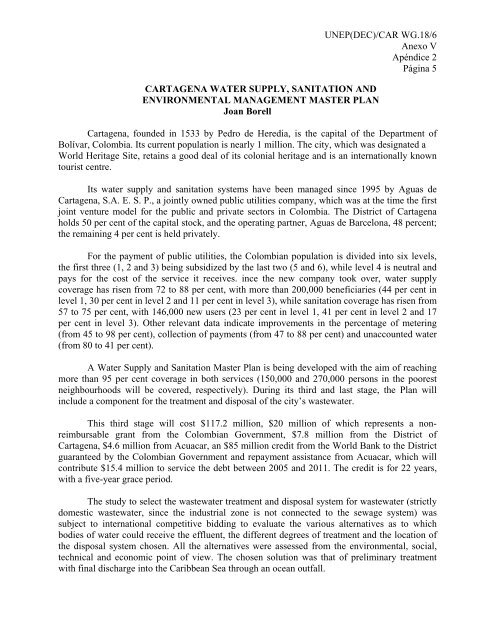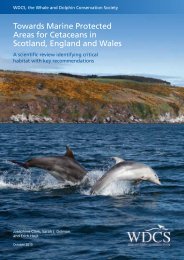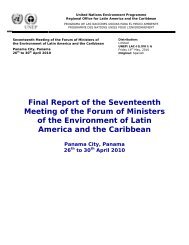Caribbean Environment Programme - UNEP
Caribbean Environment Programme - UNEP
Caribbean Environment Programme - UNEP
Create successful ePaper yourself
Turn your PDF publications into a flip-book with our unique Google optimized e-Paper software.
<strong>UNEP</strong>(DEC)/CAR WG.18/6<br />
Anexo V<br />
Apéndice 2<br />
Página 5<br />
CARTAGENA WATER SUPPLY, SANITATION AND<br />
ENVIRONMENTAL MANAGEMENT MASTER PLAN<br />
Joan Borell<br />
Cartagena, founded in 1533 by Pedro de Heredia, is the capital of the Department of<br />
Bolívar, Colombia. Its current population is nearly 1 million. The city, which was designated a<br />
World Heritage Site, retains a good deal of its colonial heritage and is an internationally known<br />
tourist centre.<br />
Its water supply and sanitation systems have been managed since 1995 by Aguas de<br />
Cartagena, S.A. E. S. P., a jointly owned public utilities company, which was at the time the first<br />
joint venture model for the public and private sectors in Colombia. The District of Cartagena<br />
holds 50 per cent of the capital stock, and the operating partner, Aguas de Barcelona, 48 percent;<br />
the remaining 4 per cent is held privately.<br />
For the payment of public utilities, the Colombian population is divided into six levels,<br />
the first three (1, 2 and 3) being subsidized by the last two (5 and 6), while level 4 is neutral and<br />
pays for the cost of the service it receives. ince the new company took over, water supply<br />
coverage has risen from 72 to 88 per cent, with more than 200,000 beneficiaries (44 per cent in<br />
level 1, 30 per cent in level 2 and 11 per cent in level 3), while sanitation coverage has risen from<br />
57 to 75 per cent, with 146,000 new users (23 per cent in level 1, 41 per cent in level 2 and 17<br />
per cent in level 3). Other relevant data indicate improvements in the percentage of metering<br />
(from 45 to 98 per cent), collection of payments (from 47 to 88 per cent) and unaccounted water<br />
(from 80 to 41 per cent).<br />
A Water Supply and Sanitation Master Plan is being developed with the aim of reaching<br />
more than 95 per cent coverage in both services (150,000 and 270,000 persons in the poorest<br />
neighbourhoods will be covered, respectively). During its third and last stage, the Plan will<br />
include a component for the treatment and disposal of the city’s wastewater.<br />
This third stage will cost $117.2 million, $20 million of which represents a nonreimbursable<br />
grant from the Colombian Government, $7.8 million from the District of<br />
Cartagena, $4.6 million from Acuacar, an $85 million credit from the World Bank to the District<br />
guaranteed by the Colombian Government and repayment assistance from Acuacar, which will<br />
contribute $15.4 million to service the debt between 2005 and 2011. The credit is for 22 years,<br />
with a five-year grace period.<br />
The study to select the wastewater treatment and disposal system for wastewater (strictly<br />
domestic wastewater, since the industrial zone is not connected to the sewage system) was<br />
subject to international competitive bidding to evaluate the various alternatives as to which<br />
bodies of water could receive the effluent, the different degrees of treatment and the location of<br />
the disposal system chosen. All the alternatives were assessed from the environmental, social,<br />
technical and economic point of view. The chosen solution was that of preliminary treatment<br />
with final discharge into the <strong>Caribbean</strong> Sea through an ocean outfall.

















